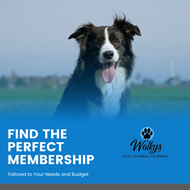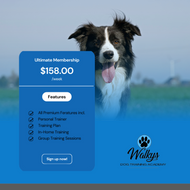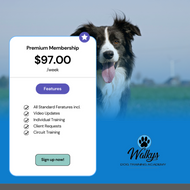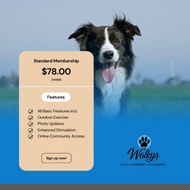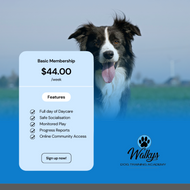August 1, 2025
The Truth About the Cavoodle
Cute as hell, but is your lifestyle up for the challenge?
There’s a reason the Cavoodle is one of Australia’s most popular dogs. They’re adorable, affectionate, and normally non-shedding, right? Sure. But that’s not the whole story.
For every calm lapdog curled up with a family in Wollongong, there’s another one barking at shadows, riddled with anxiety, and chewing furniture because their owners bought the fluff but skipped the follow-through.
Let’s unpack it properly.
Where They Come From
The Cavoodle is a designer crossbreed. A Cavalier King Charles Spaniel mixed with a Poodle. It started in Australia, bred as a low-shedding companion dog. The idea was to combine the sweet nature of the Cavalier with the brains and coat of the Poodle.
What you actually get is a clever, affectionate, emotionally tuned-in dog. If you raise them right, they’re magic. If you don’t, they unravel fast.
Fulfilment Needs
Cavoodles don’t need marathon runs or ten-kilometre hikes. What they need most is you. Daily interaction, calm exposure to the world, training, and a structured routine. They’re a relationship-based dog, not a backyard pet.
We use the Fulfilment Formula to build balanced dogs. That means getting these five pillars right:
-
Nutrition
-
Exercise
-
Stimulation
-
Training
-
Structure
Skip one and you’ll see the cracks. Barking. Whining. Clinginess. Shadow-chasing. These are the signs of a dog without direction.
Training and Temperament
Cavoodles are eager to learn and desperate to be with you. That’s a double-edged sword. Training is easy if you’re calm, consistent, and clear. But without boundaries, they can become full-blown velcro dogs.
From day one, focus on independence. Crate training, place training, and solo time are essential. They don’t need yelling or harsh corrections. They need guidance. Fair and simple.
Family Fit
They’re often great with kids and suit first-time owners who are willing to learn. The risk? Many people raise them like human babies instead of dogs. They let the dog bark at everything, carry them everywhere, and reward nervous behaviour.
It’s not kind. It’s confusing.
Raise them with kindness and structure, and they’ll be the best mate your family ever had.
Health and Nutrition
Cavoodles are prone to a few common issues:
-
Dental disease
-
Luxating patellas (knee slips)
-
Chronic ear infections
-
Food sensitivities and skin flare-ups
They need clean food with good protein, omega oils, and plenty of support for gut and joint health. Raw and kibble combos work well. Budget around $120 per month on food and supplements. Regular check-ups help keep bigger vet bills at bay.
Grooming and Maintenance
Here’s the myth: they don’t shed so they’re easy.
Here’s the truth: the coat needs constant care.
Brush them every 2 or 3 days. Book professional grooms every 6 to 8 weeks. If you don’t, the coat mats. Once that happens, they’ll need to be shaved. There’s no workaround.
Rescue or Breeder?
Cavoodles are one of the most puppy-farmed breeds in the country. Do your homework. If you go to a breeder, ask about:
-
DNA health testing
-
Early socialisation
-
Parental temperament
If you rescue, understand that many come with separation anxiety or limited structure. That’s fixable, but only if you’re ready to put in the time.
The Money
-
Upfront cost: $1500 to $5000
-
Monthly cost: around $250 for food, grooming
-
Emergency buffer: $1000 to $3000 for patella surgery, dental work, or infection treatment
These dogs cost less to feed than a Staffy, but more to maintain overall.
Who They're Right For
✅ Calm homes with routines
✅ Families who enjoy hands-on dog care
✅ Owners willing to learn, train, and brush regularly
❌ People who are out of the house all day
❌ Anyone looking for a low-maintenance breed
❌ Owners who confuse spoiling with love
The Real Talk
Pros:
-
Beautiful temperament when raised well
-
Easily trained with food and affection
-
Good for apartment life
-
Soft, cuddly, and loyal
Cons:
-
High grooming demands
-
Prone to anxiety if structure is missing
-
Can become yappy
-
Dental care is non-negotiable
Trainer’s Tip
Start crate and place training in Week 1. Don’t wait for barking or anxiety to appear. Build independence through short solo breaks, especially after play or meals. Use enrichment daily. Snuffle mats, food puzzles, soft tug toys. And reward calm behaviour every time you see it.
Final Thoughts
If you want a gentle, loving dog who thrives on connection and calm — the Cavoodle is a top contender. But if you’re hoping to skip the training, the grooming, and the structure, this isn’t the breed for you.
Done right, they’ll be the sweetest soul you’ve ever met. But they don’t raise themselves.
Thinking of adding a Cavoodle to your family? Book a call or visit Walkys. We’ll help you raise one that’s confident, calm, and truly fulfilled.




